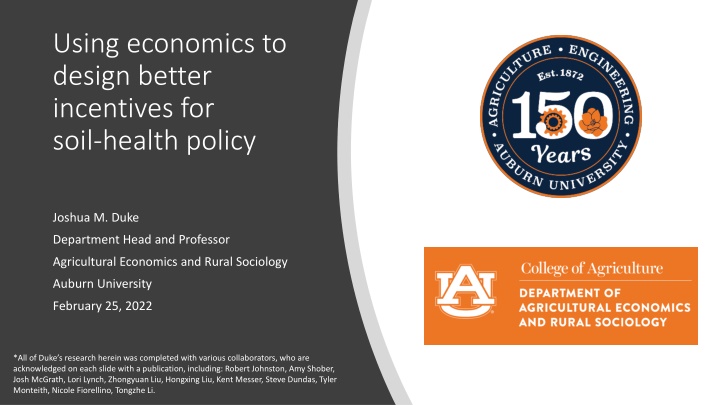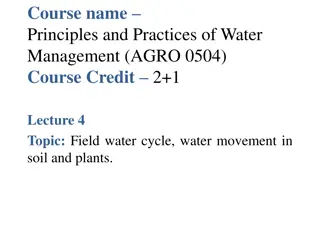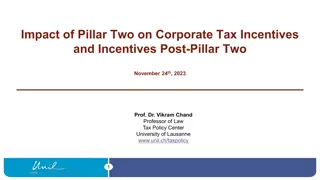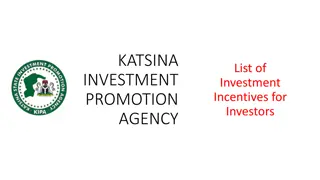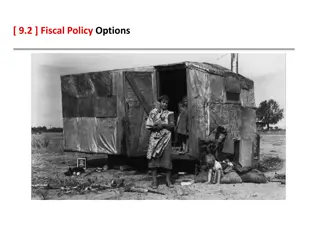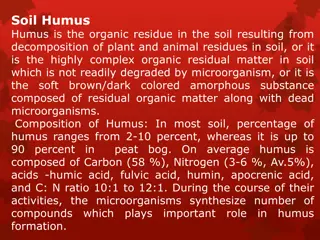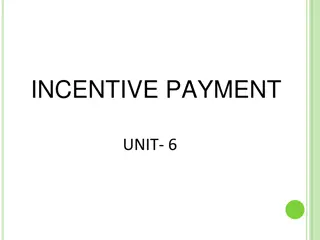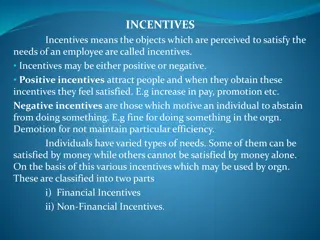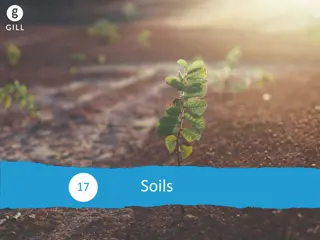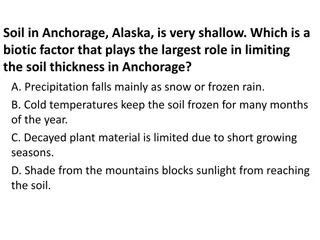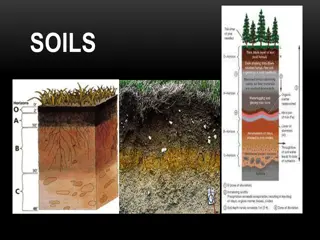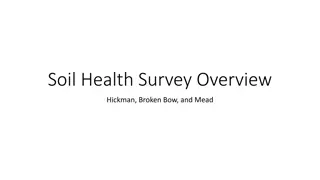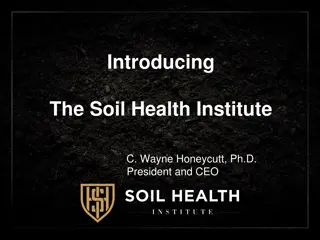Economics for Improving Soil Health Policy Incentives
Utilizing economic principles to enhance incentives in soil health policies can lead to more effective programs. Government initiatives already incorporate economic designs, but there is room for improvement. Factors such as recruitment strategies, benefit heterogeneity, and budget allocation can be optimized to encourage better outcomes for farmers and the environment.
Uploaded on Oct 01, 2024 | 2 Views
Download Presentation

Please find below an Image/Link to download the presentation.
The content on the website is provided AS IS for your information and personal use only. It may not be sold, licensed, or shared on other websites without obtaining consent from the author.If you encounter any issues during the download, it is possible that the publisher has removed the file from their server.
You are allowed to download the files provided on this website for personal or commercial use, subject to the condition that they are used lawfully. All files are the property of their respective owners.
The content on the website is provided AS IS for your information and personal use only. It may not be sold, licensed, or shared on other websites without obtaining consent from the author.
E N D
Presentation Transcript
Using economics to design better incentives for soil health policy Joshua M. Duke Department Head and Professor Agricultural Economics and Rural Sociology Auburn University February 25, 2022 *All of Duke s research herein was completed with various collaborators, who are acknowledged on each slide with a publication, including: Robert Johnston, Amy Shober, Josh McGrath, Lori Lynch, Zhongyuan Liu, Hongxing Liu, Kent Messer, Steve Dundas, Tyler Monteith, Nicole Fiorellino, Tongzhe Li.
Many Government Programs on Soil Health Already Have Economic Design Elements 1. Voluntary and Incentive-Based 2. Budget Constrained (with Reverse Auctions) 3. Internalizing Externalities/Corrects a Market Failure Can we do better? *Qualification: Some programs have more advanced economic designs than others.
Recruitment & Education Efforts Program Rules Program Budget What does better mean to an economist? Population of Farmers Selection Process From Pool of Applicants Improving cost effectiveness Getting more for the same budget Pursue BMP without Cost-Share Cost-Share Awarded Off-farm benefits lead to the following framing: Governments procure services from farmers How can governments procure off-farm benefits cost effectively? Monitorable Change True Change Change in Off-Farm Benefits Change in On-Farm Soil Health & Farm Profitability Future Farmer Behavioral Change
Benefit heterogeneity: More extensive than you might think 1200 1000 Predicted Net Benefit Range of Grass Buffer Net Benefits ($/acre/year) 800 More heterogeneity lets market-based solutions outperform regulatory solutions 600 400 200 0 Figures show modeled heterogeneity Field-level N and P reductions in Eastern Shore Maryland BMP off-farm productivity varies tremendously within and between BMPs 1 4 7 1013161922252831343740434649525558616467707376 -200 Maximum net benefit Minimum net benefit Average net benefit Predicted Net Benefit Range Decision Agriculture 0 1 4 7 1013161922252831343740434649525558616467707376 Net Benefits ($/acre/year) -5 -10 -15 -20 -25 Qualification: the setting is water quality trading and not cost-share -30 -35 Fields Maximum net benefit Minimum net benefit Source: Duke, Liu, Monteith, McGrath, Fiorellino. 2020. A method for predicting participation in a performance- based water quality trading program. Ecological Economics 177:106762. Average net benefit
Topic: Lower Payments, Targeting, and Contract Flexibility Q: Can programs be made more attractive to some farmers? A: Yes, by taking advantage of information on heterogeneity Q: If the programs are more attractive, can we lower the required participation incentive? A: Yes, and this allows for more participation from the same budget
Tailoring programs to farmer needs in different regions Ohio Maryland IMPORTANCE KNOWLEDGE ROI Some heterogeneity between regions can be picked up through surveys RISK COSTS-LABOR Offering region-specific education ought to lead to lower concerns about cover crops when compared to national-level education COSTS-SEED EQUIPMENT OTHER 0 0.05 0.1 0.15 0.2 0.25 0.3 0.35 0.4 0.45 0.5 Farmers reported barriers to cover crop adoption from Northwest Ohio and Maryland Duke, Joshua M., Robert J. Johnston, Amy L. Shober, and Zhongyuan Liu. 2022. Barriers to cover crop adoption: Evidence from parallel surveys in Maryland and Ohio. Forthcoming in May issue at Journal of Soil and Water Conservation
Recognize farmers portfolio approach Prob (CC) Soil health programs are organized around their sponsoring governmental units However, farmers look across many programs when optimizing participation Prob (CC|CRP) Ohio Predictions Maryland Predictions Farmers ought to see economies of scale in participating The marginal cost of the second signup ought to be lower than the first signup Prob (CC|CRP, Commodity, Other) This means that analysis of participation of any one program might overestimate the costs needed to attract a participant Duke, Johnston, Shober, and Liu. 2022. Improving targeting of farmers for enrollment in Agri-Environmental Programs. Forthcoming at Applied Economic Perspectives & Policy.
Flexible contract design Eg 1: Planting cover crops 2 weeks early MD already offers bonuses ($5-$20) Our data show that on average, MD farmers do indeed require roughly $17 However, the heterogeneity is so large that some farmers might need much more than $17 to enroll and others might need far less or even $0 Economic point: Accommodate heterogeneity The flat incentive thus overpays some and completely misses others More options for farmers Some options won t produce the highest off-farm benefit Eg2: MD offers 1-year contracts On average, this option was roughly $17 worse than a more flexible option we invented a 5-year contract where the farmer must plant only for 2 years But these options may be cheaper However, the estimates of heterogeneity were extreme Some farmers would accept far less for a 1-year contract and the 2 of 5 option was also available Others would need far more incentive Our data show that farmers think about contracts in complex and sophisticated ways Heterogeneity in preferences for contract length roughly 3X greater than heterogeneity for early planting *All values are per acre Preliminary results (not for citation until peer review process completes) from cover crop survey in MD run by Duke, Johnston, and Shober. Preliminary analysis by Mahmood.
Flexible contract design (continued) Eg4: Targeting on farmer age and experience Our results show how much more incentive ($) on average that older and more experienced farmers need relative to younger farmers for the exact same contract Eg3: Contract-required seed types and seeding rates Can non-monetary incentives be used? On average, barley required the same incentive as rye But wheat was preferred more than twice as much Eg5: With free seed, how much lower would the payment be on average (per acre)? Rye seed on average is worth roughly $50 However, average preferences for each seed type interact with preferences for seeding rates and each of these options has significant heterogeneity Radish seed on average is worth roughly $20 However, preference heterogeneity is large. Some might value free seeds while others would never accept them This means that program managers might Get higher participation if more options are offered Target contracts to specific farmers such that it is so attractive to them, they accept a lower payment Eg6: What if farmers could harvest the cover crop in the spring rather than killing it? On average spring harvest is worth roughly $23 acre Once again, significant heterogeneity on this One size does not fit all for contracting we knew this, but it is even more heterogeneous than existing programs allow Preliminary results (not for citation until peer review process completes). From survey run by Duke, Johnston, and Shober. Preliminary analysis by Mahmood.
Topic: Refining Program Eligibility Rules and Auction Design Q: Can capping years of cost-share increase overall adoption? A: Maybe. New evidence suggests yes with cover crops Q: Can reverse auctions be refined to further lower procurement cost? A: Yes
Limited Contract Renewability? Blue: Maryland farmers in MD State CC program Orange: Ohio farmers in EQIP CC incentive 60 Message: For some farmers, limited-term cost share (say, 3-5 years) might be enough for self adoption 40 More-permanent funding on year-to-year contracts might either create dependence or lessen the incentive to gain experience 20 MD-IV OH-IV How much will cover crop plantings drop if Cost-Share Ends? MD OH 0 0 1 2 3 4 5 6 7 CCEXP in years Source: Duke, Liu, Johnston, Shober. 2021. Does farmer experience or cost share lead to more sustained adoption of cover crops. Manuscript and AAEA presentation.
What auction design characteristics reduce procurement costs? There is some research evidence: Which has the lowest procurement cost? Fixed price cost share, Uniform price auctions, Discriminatory price auctions Even though UP is incentive-compatible Extensive research literature on auction design from experimental economics What happens when respondents participate in the same type of auction year after year? Per-unit procurement cost goes up or down How much information should be provided in a discriminatory price auction? None, some, all Many experiments with information and participant communication See Schilizzi (2017) for a broad review and more details; also recent work by Boxall and collaborators and Palm-Forster and collaborators. These sources point you to many other works. Qualification: Most of this research literature assumes cost heterogeneity and benefit homogeneity Will larger budgets increase per-unit procurement costs, all else equal? Yes or no Duke, Messer, Lynch, and Li. 2017. The effect of information on discriminatory-price and uniform-price reverse auction efficiency. Strategic Behavior and the Environment 7:41-71.
Topic: Increase Effectiveness By Using Benefit and Cost Information for Targeting Q: Should programs procure (select applicant farms) using a least-cost approach? A: No, unless the off-farm benefits are homogeneous. Also, additionality should be considered
Targeting for off-farm benefits Selecting Farms for Conservation Easements with Different Targeting Strategies and $30 Million Budget Source: Duke, Dundas, Johnston, Messer. 2014. Prioritizing payment for environmental services: Using nonmarket benefits and costs for optimal selection. Ecological Economics 105:319-29.
Topic: Many Other Considerations for Cost- Effectiveness Q: Would a farmer adopt a practice without cost share? Can we sort on this? A: Some would and, yes, but it is difficult Research: Use mechanism design to create sorting contracts. This means farmers who are most likely to adopt without cost share voluntarily select a low-payment contract and farmers least likely to adopt without cost share select a high-payment contract (Arnold, Duke, Messer 2013) These contracts can be designed without knowing an individual farmer s type Q: Even if nonadditionality exists, is it a big deal? A: Maybe not, but mixed evidence Research: With cover crops, no, maybe, yes See Lichtenberg, Fleming et al., Sawadgo and Plastina, and others Yes, under water quality trading (Duke et al.) Others: Agglomeration economies, transaction costs, off-farm benefits also depend on policy instrument, conservation incentives of renters vs owners, etc.
Conclusion: Economic Results Generalized This presentation reviews some recent economic research results on improvements to procurement of off-farm benefits using soil health programs Here are the general types of economic problems and solutions: Programs should select participants using on-farm cost and off-farm benefit information when possible Information asymmetry prevents program managers from knowing the true costs for a farmer to adopt a BMP This means that it will not be possible to take advantage, fully, of the cost heterogeneity that warrants the use of markets in the first place Some farmers may be paid for BMPs that they would adopt without cost-share (nonadditionality) There is a related argument for information costs in monitoring the off-farm effectiveness of BMPs Farmer soil health program decisions are typically more complicated than whether to enroll or not in a single program If permitted, farmers are likely to adjust their broader land management decisions after enrolling, which often will reduce the anticipated off-farm benefits (leakage)
